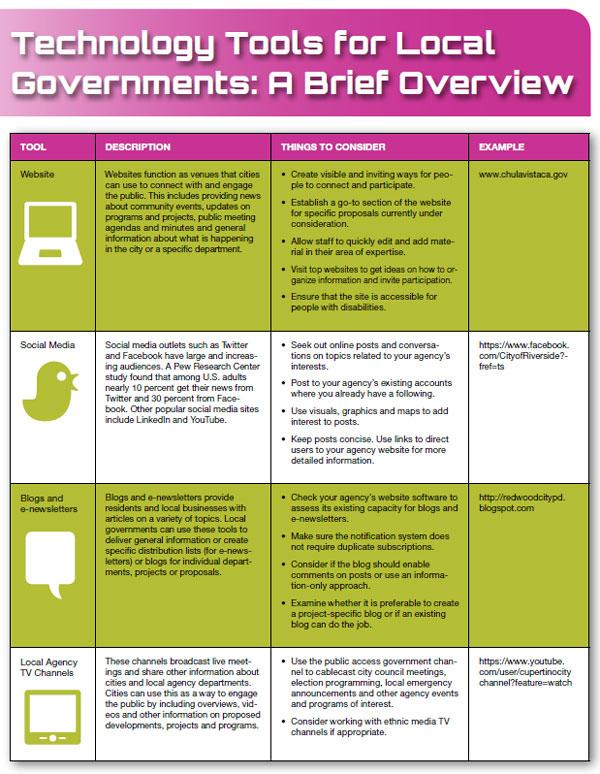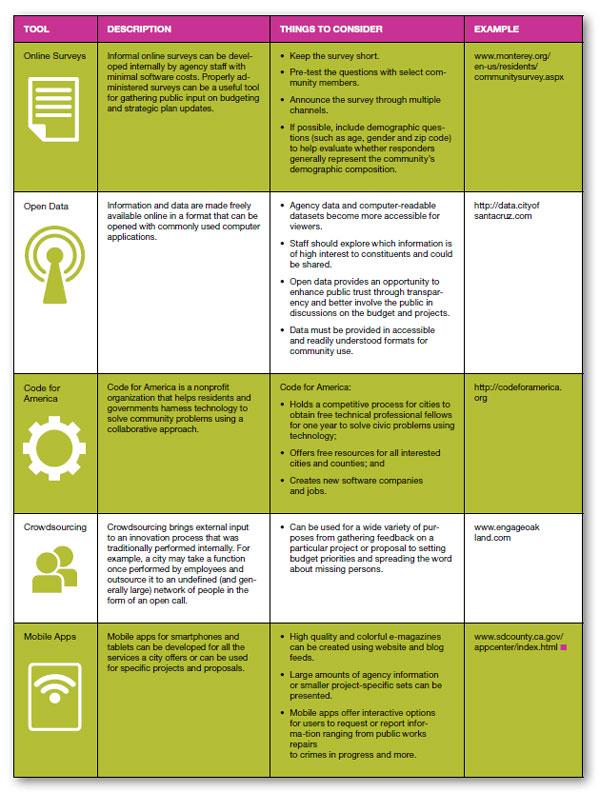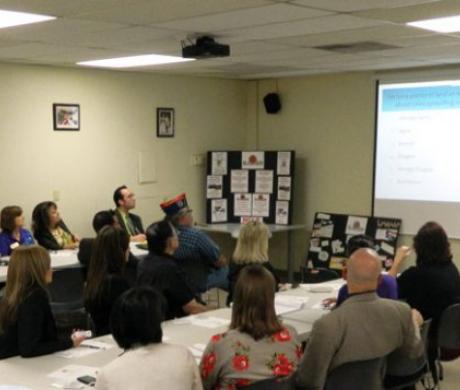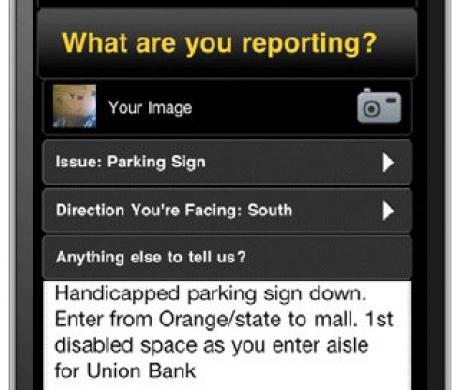Technology, Tools and Techniques to Reach Your Community
The Institute for Local Government Public Engagement Team members who contributed to this article include Terry Amsler, Melissa Kuehne, Christal Love Lazard and Sarah Rubin. Special thanks to consultants Susan Stuart Clark and Brian Moura, who also contributed to this article. The Institute for Local Government (ILG) is the nonprofit research affiliate of the League and California State Association of Counties. For more about ILG’s Public Engagement program, visit www.ca-ilg.org/public-engagement.
Local governments frequently use technology to engage their communities in public meetings and the decision-making process. Many such options are outlined in new resources available from the Institute for Local Government (ILG), the research and education affiliate of the League and the California State Association of Counties. (Find ILG’s free resources on public engagement and technology online at www.ca-ilg.org/public-engagement-technology.)
Benefits of Increased Public Engagement
Increasing public engagement in your community offers many benefits. Engaging the public early in the decision-making process can help local public agencies avoid costly pitfalls and mistakes. Involving residents and others in the process can generate more support for the final decisions reached by city or county decision-makers. Constituents who have helped shape a proposed policy, project or program typically have a better understanding of the issues at hand and the reasoning behind the final decision. Participation helps generate ownership. Effective communication about the public’s involvement in a local decision can broaden community support.
Most California cities have diverse populations, and many communities are experiencing rapid demographic changes. Community composition varies by age, gender, ethnicity, immigrant status and income level. Incorporating technology into standard public engagement channels, such as flyers and mailers, can increase the reach of an agency’s engagement efforts.
Exploring Technology Options and Costs
Local governments use a wide variety of technology options in their efforts to connect with their communities. While some technology may be costly, many options are reasonably priced and the range of available choices is broad enough to be feasible for any local government, from large to small. Examine the costs and benefits associated with the options that seem to offer the best fit for your agency’s needs.
Maximize communications and outreach methods already in place. All local agencies have outreach and engagement channels in place. Local governments can take advantage of these current vehicles to better engage the public as well. Although many of these options cost only staff time, that is nevertheless a very valuable resource. Communication channels such as newsletters, websites, social media, blogs, local government TV channels and online surveys are vital to engaging the public and can often be better utilized by local agencies. For tips on these communication vehicles and examples of local governments that are maximizing these tools, see “Technology Tools for Local Governments: A Brief Overview”.
Emerging Technologies
For local jurisdictions interested in pursuing more advanced options, technology allowing open access to public agency data and the development of mobile apps is now more accessible to local governments.
Open Data
Open data refers to making information and data freely available online. The data must be presented in “usable form,” which generally consists of a clear visual format and easy access via commonly used computer software. Local agencies can use this approach to post information such as maps, data sets, tables and documents. This allows residents and other interested parties to view and analyze the data. Many cities throughout California are using open data platforms for a variety of purposes that include sharing census redistricting data and geographic information systems (GIS) and establishing local budget priorities.
Local government agencies that have implemented open data cite several benefits:
- Increased transparency. If all information is open and accessible to the public, it helps convey that the agency’s operations are transparent;
- Time and cost savings. Open data can save local jurisdictions some of the costs and staff time associated with requests for public records; and
- Checks and balances. Because open data allows all community members access to the same information, it can create a checks and balances system to identify if data has been manipulated.
Other things to consider include:
- The need for education. Agency staff and officials may need to be educated on the meaning of open data and how its use can affect and benefit their particular jurisdiction.
- Local governments have limited resources. Because of this, it’s necessary to present a compelling case for why open data is important. It can be helpful to identify a champion — for example, the city manager, chief information officer or a city council member — to build support from other departments and elected officials.
- Governance structure. Once the decision to implement open data has been made, the local government will need to establish policies and procedures to ensure the quality and uniformity of the data.
The City of Santa Cruz (http://data.cityofsantacruz.com/) and the City of Sacramento (http://portal.cityofsacramento.org/OpenData) provide two examples of how local agencies are offering residents access to open data.
“In addition to increasing transparency and accountability — which can lead to greater trust with constituents — open data can enable innovators to build useful applications, analysts to find helpful insights and innovators to create derivative value,” says Palo Alto Chief Information Officer Jonathan Reichental. “Done right, there is little downside and a high-value upside.”
Mobile Apps
Once your agency has its data, such as tables and budget information, in a usable form, agency staff can convert this information into mobile apps. These apps can be developed for all the services a city offers, bundling large amounts of information, or can be used for specific departments, projects and proposals. Uses can range from municipal services and cultural attractions to civic engagement. It is always important to keep the user in mind and focus on the information the user needs or seeks.
With increasing numbers of people using smartphones, many local jurisdictions are developing mobile apps for their residents. For example, San Diego County has developed an app center (www.sdcounty.ca.gov/appcenter/index.html) to provide residents access to county information and services, such as fire and police and reports on beach water quality, while on the go. The City of Elk Grove (www.elkgrovecity.org/ask-elk-grove/mobile.asp) also offers an app that allows residents to obtain city news and information on public meetings and events and submit non-emergency service requests.
Code for America
Code for America (http://codeforamerica.org), a nonprofit organization, focuses on how technology can help governments operate more collaboratively and efficiently. Local agencies can partner with Code for America through programs such as:
- Fellowship — links technology volunteers with local agencies to build apps and inspire innovative thinking;
- Brigade — connects volunteers and government employees to help sustain open data infrastructure; and
- Peer Network — allows government officials and staff to share resources, best practices and open data policies.
Crowdsourcing
Crowdsourcing is the practice of engaging large groups of people, including online communities, to obtain input. It can be used for a wide variety of purposes from gathering feedback on a particular project or proposal to setting budget priorities or spreading the word about missing persons. Several for-profit and nonprofit vendors have developed crowdsourcing technology designed with local government in mind. These platforms are becoming an increasingly popular method for connecting with community members who might not otherwise participate through traditional means, such as city council meetings or public hearings.
Crowdsourcing platforms typically use vibrant graphic design and offer sophisticated statistical analysis of inputs. Some might think of these efforts as online town hall meetings where ideas are shared and the most popular ones can emerge. Engage Oakland (www.engageoakland.com/) and the City of Salinas (www.peakdemocracy.com/portals/164) offer innovative examples of such efforts.
One potential concern about online engagement is the voluntary and often anonymous nature of the participation, which may not be completely representative of the entire community. While this issue is perhaps most frequently raised about crowdsourcing, it also applies to other communication channels.
Conclusion
With increasing numbers of people using online platforms to get news and information, local jurisdictions have additional opportunities to reach and connect with their communities. The options outlined here should be used in conjunction with nontechnical, traditional engagement and outreach efforts as part of a comprehensive approach.
Interested in Learning More?
The Institute for Local Government will be offering a free webinar on “Technology, Tools and Techniques to Improve Public Engagement” on June 18, 2014, from 10:00 to 11:00 am. Panelists will discuss:
- Ideas on how to use technology to get the word out and encourage more participation in the public engagement process;
- Methods of coordinating digital engagement with in-person meetings and typically traditional forms of outreach to generate more ideas and input from the community;
- Tips on how to use this input to enhance local agency decision-making; and
- Examples of cities and counties that are reaching and engaging new audiences.
To register, visit www.ca-ilg.org/post/technology-tools-and-techniques-improve-public-engagement.
Technology Tools for Local Governments: A Brief Overview
The Institute for Local Government offers a wide variety of free resources on public engagement at www.ca-ilg.org/public-engagement.
This article appears in the June 2014 issue of Western City
Did you like what you read here? Subscribe to Western City









